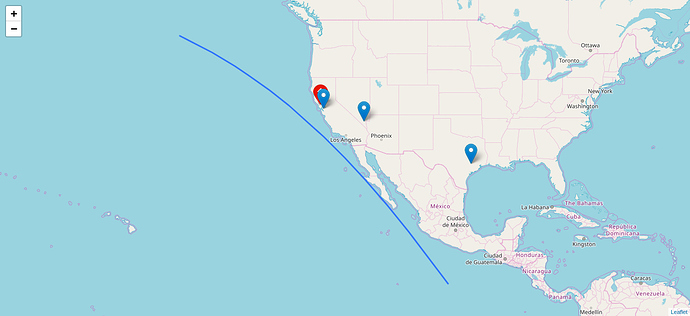Bishop O’Connell High School, Arlington, VA, telebridge via W6SRJ
The ISS callsign is presently scheduled to be NA1SS
The scheduled astronaut is Serena Aunon-Chancellor KG5TMT
Contact is a go for: Thu 2018-11-08 15:56:28 UTC 51 deg
Several stations were able to receive parts of the contact:
- SatNOGS Network - Observation 316092 - Station: 77 - N5CNB-VHF
- SatNOGS Network - Observation 316094 - Station: 213 - W5SAT_VHF
- SatNOGS Network - Observation 316093 - Station: 129 - Chabot Space and Science Center
Map of the ground track, the above mentioned SatNOGS ground stations and the contact site:
video: Arlington high school students make contact with astronaut via ham radio - YouTube
Congratulations and 73 to all!
More details about the contact from AMSAT-BB:
Click here for the details
An International Space Station school contact has been planned with participants at Bishop O’Connell High School, Arlington, VA on 08 Nov. The event is scheduled to begin at approximately 15:56 UTC. It is recommended that you start listening approximately 10 minutes before this time.The duration of the contact is approximately 9 minutes and 30 seconds. The contact will be a telebridge between NA1SS and W6SRJ. The contact should be audible over the west coast of the U.S. Interested parties are invited to listen in on the 145.80 MHz downlink. The contact is expected to be conducted in English.
Bishop O’Connell High School is a diocesan Catholic college-preparatory high school founded in 1957 and located in Arlington, Virginia. Drawn from the diverse population of Northern Virginia, Washington, D.C., and Maryland, The student body of 1,200 represents a range of socioeconomic, racial, ethnic and religious heritage. The school offers a technology-infused, student-centered, learning environment, with an average class size of 17.
Unique learning experiences include robust curriculum choices in the fields of science, technology, engineering and mathematics (STEM)–including a Project Lead the Way (PLTW) engineering curriculum–dual credit offerings with Marymount University, and an optional Global Studies program.
Our academic rigor is enriched through the opportunity for independent research projects and supplemental club activities and programs that infuse a strong STEM focus throughout our school.
Faculty at O’Connell collaborate through STEM-driven projects that include using innovative technology solutions and the use of big data to study our world. These activities include building and tracking satellites, small chip payload development, high-altitude balloon experiments, using big data to solve real-world problems, underwater robotics, coding, and Amateur Radio.
And lastly, we love exploring space and space-related activities at Bishop O’Connell!
Participants will ask as many of the following questions as time allows:
-
In regards to the future of space travel, what will help us accomplish our space goals the most, government or commercial space industry?
-
What is it like to float in space? Is it peaceful, is it nerve wracking?
-
When you arrived on the International Space Station, how long did it take for you to adjust your sleeping habits and how long do you guys normally sleep?
-
Does homesickness affect you (the astronaut) and if it does, how do you cope with it.
-
Did you bring anything to remind you of your family?
-
What does a rocket launch feel like?
-
Will you use ham radio after leaving the ISS? We hope we can talk to you through our radio once you are back on earth.
-
How do you navigate your way through the space station if almost every room looks the same?
-
What are your thoughts on humans visiting Mars? When do you think it will happen, if at all?
-
What do you do in your free time?
-
How much replanning is happening in your workdays because the other two astronauts are not there?
-
Can you see the leaves changing in the Northeast US? Elsewhere in the world?
-
New satellites such as GOES16 produce incredibly detailed images which we look at here on the Internet. Do you use those images to help guide your observations from ISS?
-
Of all those different nationalities, has anyone held worship services? Aboard, or from the ground?
-
Is there static electricity in space? How do you deal with it?
-
How are you celebrating NASA’s 60th anniversary?
-
Have you ever been on an EVA walk? If so, what was the task?
-
How much humidity is there on the ISS? Is the air ever too dry or to moist?
-
It snowed recently in the Allegheny Mountains not far from us, can you see snow from space?
[…]
About ARISS:
Amateur Radio on the International Space Station (ARISS) is a cooperative venture of international amateur radio societies and the space agencies that support the International Space Station (ISS). In the United States, sponsors are the Radio Amateur Satellite Corporation (AMSAT), the American Radio Relay League (ARRL), the Center for the Advancement of Science in Space (CASIS) and National Aeronautics and Space Administration (NASA). The primary goal of ARISS is to promote exploration of science, technology, engineering, and mathematics (STEM) topics by organizing scheduled contacts via amateur radio between crew members aboard the ISS and students in classrooms or informal education venues. With the help of experienced amateur radio volunteers, ISS crews speak directly with large audiences in a variety of public forums. Before and during these radio contacts, students, teachers, parents, and communities learn about space, space technologies, and amateur radio. For more information, see www.ariss.org, www.amsat.org, and www.arrl.org.
Thank you & 73,
David - AA4KN
